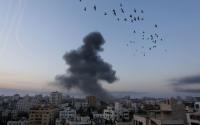15 February 2005Thomas E. Lovejoy and Lee Hannah
Scientists met in Britain recently to discuss what level of greenhouse gas concentrations constitutes "dangerous interference" with the global climate. Instead we should be focusing on what are safe levels. Without such guidance, global climate efforts are tantamount to walking blindfolded toward the edge of a cliff.The global instrument for dealing with climate change, the International Convention on Climate Change, is designed to avoid dangerous interference in agriculture, economies and ecosystems. Since the convention came into existence in 1992, it has become increasingly apparent that ecosystems are the most sensitive of the three. There is statistically sound evidence that climate change has already altered flowering and nesting times, and the distribution of birds, butterflies and marine organisms. More disturbing is the first extinction associated with climate change - in conservation-conscious Costa Rica - and the widespread and massive bleaching of coral reefs from warmer seas added to other stresses. Ecosystem failures, like those of corals and huge forests of Alaskan spruce weakened by more than 15 years of above average temperature, can be considered a preview of more such events to come.As scientists look ahead at the impacts of additional climate change on biological diversity, a pattern is emerging, no matter how imperfect, of serious biological degradation and species loss. Compounding the problem of climate change, landscapes modified by humans can hinder the movement of organisms - the normal response in past climatic changes, such as the glacial-interglacial swings dominant in the recent geological past of the Northern Hemisphere.The 1992 convention specifically addresses rapidity of climate change, citing the need not to exceed rates at which species can adapt naturally. Ignoring the distinct possibility that it is a mistake to assume climate change will only be gradual and never have abrupt episodes, it is clear that some species and ecosystems will not be able to adapt above certain levels of climate change no matter how leisurely the rate of change. Ecosystems of low-lying islands will succumb to rising sea levels and those on mountain tops will have nowhere to go as it becomes too warm for them. Safe levels of climate change would avoid such ecosystem disruption and the associated wave of extinctions. But what might constitute safe levels? There are almost certainly multiple ones. Where we are right now is probably safe even with 0.8 degrees Celsius of average global warming, plus whatever additional warming would take place because of the lag between an increase in gases and one in temperature. But it is impossible to stop at this level because of rates of emissions from current energy use.There seems to be a growing consensus that a safe level would be a carbon dioxide concentration of 450 parts per million or less. (The pre-industrial level was 280 ppm; today's is 379 ppm). That translates into an average global warming of 2 degrees Celsius. While hard to achieve, and complicated by the need to take other greenhouse gases into account, the sooner such a target is agreed upon, the easier it is to achieve. Focusing solely on what level constitutes "dangerous interference" carries many perils. With that level not determined, it is hard to determine what and how much to do about greenhouse gases. It is also possible that consensus might drift to a level as close as possible to the danger zone simply because it seems easier to do so. Where does the burden of proof lie? In the current debate it is up to science to prove that a level constitutes dangerous interference. If the debate is around safe levels, the responsibility is to prove that a level is safe. That more prudent approach is particularly warranted because the consequences of this environmental problem are of a global scale.For its entire history, the human enterprise has been based on the assumption of a stable climate. Yet today, despite all the signals from nature, we are failing to come to grips with the fact that we are changing the climate ourselves. It is time to focus the debate on what constitutes safe levels of greenhouse gases before it is too late.
http://www.iht.com/bin/print_ipub.php?file=/articles/2005/02/14/opinion/edlovejoy.html






